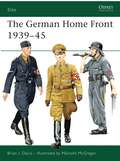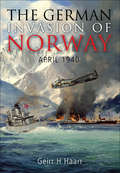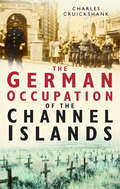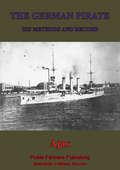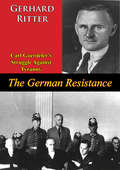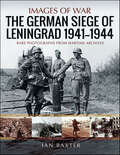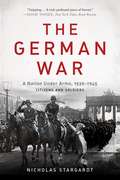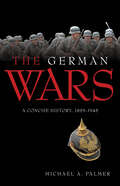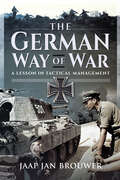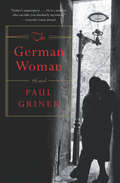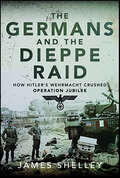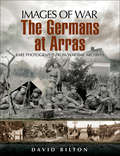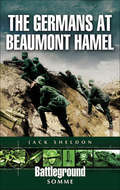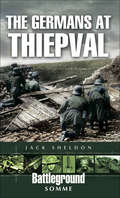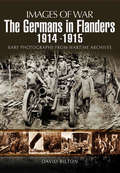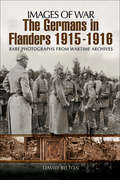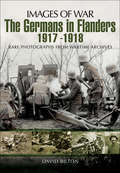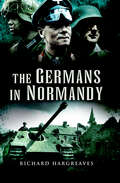- Table View
- List View
The German Girl: A Novel
by Armando Lucas CorreaAN INTERNATIONAL BESTSELLER Featured in Entertainment Weekly, People, The Millions, and USA TODAY &“An unforgettable and resplendent novel which will take its place among the great historical fiction written about World War II.&” —Adriana Trigiani, bestselling author of The Shoemaker's Wife A young girl flees Nazi-occupied Germany with her family and best friend, only to discover that the overseas refuge they had been promised is an illusion in this &“engrossing and heartbreaking&” (Library Journal, starred review) debut novel, perfect for fans of The Nightingale, Lilac Girls, and The Tattooist of Auschwitz.Berlin, 1939. Before everything changed, Hannah Rosenthal lived a charmed life. But now the streets of Berlin are draped in ominous flags; her family&’s fine possessions are hauled away; and they are no longer welcome in the places they once considered home. A glimmer of hope appears in the shape of the St. Louis, a transatlantic ocean liner promising Jews safe passage to Cuba. At first, the liner feels like a luxury, but as they travel, the circumstances of war change, and the ship that was to be their salvation seems likely to become their doom. New York, 2014. On her twelfth birthday, Anna Rosen receives a mysterious package from an unknown relative in Cuba, her great-aunt Hannah. Its contents inspire Anna and her mother to travel to Havana to learn the truth about their family&’s mysterious and tragic past. Weaving dual time frames, and based on a true story, The German Girl is a beautifully written and deeply poignant story about generations of exiles seeking a place to call home.
The German Heiress: A Novel
by Anika Scott“Meticulously researched and plotted like a noir thriller, The German Heiress tells a different story of WWII— of characters grappling with their own guilt and driven by the question of what they could have done to change the past.” —Jessica Shattuck, New York Times bestselling author of The Women in the CastleFor readers of The Alice Network and The Lost Girls of Paris, an immersive, heart-pounding debut about a German heiress on the run in post-World War II Germany.Clara Falkenberg, once Germany’s most eligible and lauded heiress, earned the nickname “the Iron Fräulein” during World War II for her role operating her family’s ironworks empire. It’s been nearly two years since the war ended and she’s left with nothing but a false identification card and a series of burning questions about her family’s past. With nowhere else to run to, she decides to return home and take refuge with her dear friend, Elisa. Narrowly escaping a near-disastrous interrogation by a British officer who’s hell-bent on arresting her for war crimes, she arrives home to discover the city in ruins, and Elisa missing. As Clara begins tracking down Elisa, she encounters Jakob, a charismatic young man working on the black market, who, for his own reasons, is also searching for Elisa. Clara and Jakob soon discover how they might help each other—if only they can stay ahead of the officer determined to make Clara answer for her actions during the war. Propulsive, meticulously researched, and action-fueled, The German Heiress is a mesmerizing page-turner that questions the meaning of justice and morality, deftly shining the spotlight on the often-overlooked perspective of Germans who were caught in the crossfire of the Nazi regime and had nowhere to turn.
The German Home Front 1939-45
by Malcolm Mcgregor Brian DavisOsprey's examination of Germany's home front situation during World War II (1939-1945). At the outbreak of war in 1939 Germany was committed to the concept of Blitzkrieg - a swift and decisive war. Yet, the reality became something very different as every corner of German society was hit by the realities of war. This book details the critical civilian support that was necessary to maintain Nazi control of the civilian population and includes first-hand accounts of the experiences of civilians who suffered at the hands of their own government as well as enduring the deprivations and fears of wartime life. With analysis and descriptions of civil and home services, from air raid wardens to postwomen, this book provides a detailed, lavishly illustrated description of wartime life in Germany, exploring the tentacles of the Nazi state as they affected every man, woman and child.
The German House
by Annette HessA December 2019 Indie Next Pick! Set against the Frankfurt Auschwitz Trials of 1963, Annette Hess’s international bestseller is a harrowing yet ultimately uplifting coming-of-age story about a young female translator—caught between societal and familial expectations and her unique ability to speak truth to power—as she fights to expose the dark truths of her nation’s past.If everything your family told you was a lie, how far would you go to uncover the truth? For twenty-four-year-old Eva Bruhns, World War II is a foggy childhood memory. At the war’s end, Frankfurt was a smoldering ruin, severely damaged by the Allied bombings. But that was two decades ago. Now it is 1963, and the city’s streets, once cratered are smooth and paved. Shiny new stores replace scorched rubble. Eager for her wealthy suitor, Jürgen Schoormann, to propose, Eva dreams of starting a new life away from her parents and sister. But Eva’s plans are turned upside down when a fiery investigator, David Miller, hires her as a translator for a war crimes trial.As she becomes more deeply involved in the Frankfurt Trials, Eva begins to question her family’s silence on the war and her future. Why do her parents refuse to talk about what happened? What are they hiding? Does she really love Jürgen and will she be happy as a housewife? Though it means going against the wishes of her family and her lover, Eva, propelled by her own conscience , joins a team of fiery prosecutors determined to bring the Nazis to justice—a decision that will help change the present and the past of her nation.
The German Invasion of Norway, April 1940: April 1940
by Geirr H Haarr&“Tremendous . . . zeroes in on the critical first days of Weserübung and offers a minutely detailed account of the unfolding action.&”—World War II This book documents the German invasion of Norway, focusing on the events at sea. More than most other campaigns of WWII, Operation Weserübung has been shrouded in mystery, legend and flawed knowledge. Strategic, political and legal issues were at best unclear, while military issues were dominated by risk; the German success was the result of improvisation and the application of available forces far beyond the comprehension of British and Norwegian military and civilian authorities. Weserübung was the first combined operation ever where air force, army and navy operated closely together. Troops were transported directly into battle simultaneously by warship and aircraft, and success required cooperation between normally fiercely competing services. It was also the first time that paratroopers were used. The following days were to witness the first dive bomber attack to sink a major warship and the first carrier task-force operations. The narrative is based on primary sources from British, German and Norwegian archives, and it gives a balanced account of the reasons behind the invasion. With its unrivalled collection of photographs, many of which have never before appeared in print, this is a major new WWII history and a definitive account of Germany&’s first and last major seaborne invasion. &“This is the author&’s first book but he has a fine natural talent for maritime history. This is a magnificent work.&”—Work Boat World &“A very impressive piece of work that comes highly recommended.&”—HistoryOfWar.org
The German Lesson
by Siegfried Lenz Ernst Kaiser Eithne WilkinsA young criminal, Siggi Jepsen, who attends German classes regularly, is asked to write about 'The Joys of Duty'. He is very familiar with 'Duties' as his father was a constable in Germany. He writes about what he has seen in his boyhood.
The German Liberation War of 1813: The Memoirs of a Russian Artilleryman
by Alexander Mikaberidze Peter G. Phillips“…may appeal to select scholars and readers interested in the era’s social history, as it ranges from social morays to different styles of flirtation, general entertainment, the theater, architecture and labor.” - Journal of Military History The second of three volumes, this book represents the first English translation of the memoirs that rank among the best in the vast Napoleonic memoir literature. The author, Ilya Timofeyevich Radozhitskii, served with distinction during the wars against Napoleon and wrote down his reminisces shortly after the war based on the notes that he kept while campaigning. Born in 1788, Radozhitskii studied at the Imperial Orphanage, enlisted in the artillery unit in 1806, and steadily rose through the ranks, earning a reputation of a capable officer. Napoleon’s invasion of Russia in 1812 changed his life. Serving as an artillery lieutenant, he saw action in virtually every major battle of that historic campaign. In 1813-1814, Radozhitskii took part in the War of the German Liberation and the invasion of France, serving with distinction at Bischofswerde, Bautzen, Katzbach, and Leipzig before finishing the war as a staff captain in Paris in 1814. Upon Napoleon’s return in 1815, Radozhitskii was assigned to the Russian Expeditionary Corps that was dispatched to France but arrived too late to confront Napoleon. Radozhitskii offers fresh insight into the life and daily experiences of Russian officers during the Napoleonic Wars. This volume follows Radozhitskii across Germany as the Russian army, buoyed by the victory over Napoleon in 1812, marched on to liberate German states. Radozhitskii’s narrative contains striking descriptions of the wartime experiences of soldiers and officers, vivid accounts of the battles, and heartrending stories from the French retreat. When published in Russia, these memoirs garnered considerable public attention and Leo Tolstoy consulted them extensively while writing his famous “War and Peace”. The first volume, entitled The Russian Campaign of 1812, was published by Pen & Sword in 2023. Volume 3, The Invasion of France 1814, will follow in 2024.
The German Occupation of the Channel Islands
by Charles CruickshankCharles Cruickshank provides a full account of the German invasion, the subsequent landings of various British agents, raids and an attempt to end the occupation using psychological warfare. He also looks at how the islanders and Wehrmacht lived, the reality of collaboration with the occupying powers and the extent of support for the Resistance.
The German Opposition to Hitler: An Appraisal
by Hans Rothfels Lawrence WilsonMore than a study of resistance among the upper ranks, author Hans Rothfels examines the unprecedented totalitarian state, armed with mid-20th century modern weapons, science, and industry.Professor Rothfels illustrates the true extent of the German resistance, its composition, aim, and the nature of its intent. He also considers the whole question of the moral and practical problems involved in opposing a totalitarian regime.
The German Pirate; His Methods And Record
by AjaxThe conflict at sea during the First World War was as tense and gripping as the battles on land; as the Allies fought the German Armies in France, the Royal Navy sought out the German Kriegsmarine on the High Seas for a decisive engagement. The German Navy was outnumbered and outgunned, and so sought to avoid fleet actions and concentrate on commerce raiding across the globe. If they could sink the lighter armed oilers, troop ships, and merchant vessels, they could force the British to the sue for peace as their sea-borne commerce dried up. However, the ships and submarines could not always distinguish between British targets and those of neutrals; the German Navy gained a reputation for ruthlessness in interpreting the rules of war. There was much indignation from the British for acts of Teutonic 'Beastliness' on the waves and hence this book detailing the cases of German misconduct and brutality. The Author, although he wrote under a pseudonym, was clearly a man of much naval experience and describes the engagements with great detail and passion.
The German Resistance: Carl Goerdeler's Struggle Against Tyranny
by Gerhard Ritter R. T. ClarkCarl Goerdeler was for a long time more than anyone else at the centre of the conspiracy against tyranny; he was in immediate personal contact with almost all of the groups and parties—and not only as a tirelessly active director and recruiting officer for the movement, but at the same time as its most productive mind when it came to working out comprehensive and mature plans dealing with both foreign and domestic problems. The German Resistance movement in its entirety can be surveyed very clearly from the vantage point of his biography. And conversely his biography is of historical significance only in the framework of this general setting. His work can be correctly estimated only when it is constantly compared with that of his colleagues. The history of the German resistance movement has hitherto been written predominantly in the form of a justification and defence against its critics, accusers, and apostates. Not infrequently it has acquired something of the flavour of a gallery of heroes or even of the lives of saints.We are here attempting something else; namely, to attain, by a critical and sober study, a grasp of the historical truth, and beyond this to search our own hearts with a new understanding. For this purpose it was indispensable to depict the German Resistance movement against the background of international politics, so far as relevant sources are now available. Likewise, the development of the movement’s ideals of freedom and plans for reform had to be traced back into the time of the Weimar Republic. And finally, its development and the political attitude of its leaders needed to be appreciated in terms of the internal and external history of Hitler’s Reich.
The German Siege of Leningrad, 1941–1944 (Images of War)
by Ian BaxterDrawing on a superb collection of rare and unpublished photographs with detailed captions and explanatory text, this dramatic book vividly portrays every aspect of the siege of Leningrad. The historic 872 day siege of Leningrad by German Army Group North began in earnest on 8 September 1941 and was not lifted until 27 January 1944. During this period the Red Army made numerous desperate attempts to break the blockade, which the Nazis and their Spanish and Finnish allies doggedly resisted. Eventually, due to overwhelming enemy pressure, Hitler’s forces were compelled to retreat, but not before looting and destroying numerous historic palaces and landmarks and looting their priceless art collections. The bitter and prolonged fighting often under appalling climatic conditions resulted in many thousands of casualties for both sides from direct action and constant indirect artillery and air attack. Arguably most shocking was the loss of life due to the systematic starvation of the civilian population trapped inside and the intentional destruction of its buildings. Drawing on a superb collection of rare and unpublished photographs with detailed captions and explanatory text, this dramatic book vividly portrays every aspect of the siege which has the dubious claim of being arguably the most costly in human and material terms of any in recent military history.
The German War: A Nation Under Arms, 1939-1945
by Nicholas StargardtAs early as 1941, Allied victory in World War II seemed all but assured. How and why, then, did the Germans prolong the barbaric conflict for three and a half more years? In The German War, acclaimed historian Nicholas Stargardt draws on an extraordinary range of primary source materials—personal diaries, court records, and military correspondence—to answer this question. He offers an unprecedented portrait of wartime Germany, bringing the hopes and expectations of the German people—from infantrymen and tank commanders on the Eastern front to civilians on the home front—to vivid life. While most historians identify the German defeat at Stalingrad as the moment when the average German citizen turned against the war effort, Stargardt demonstrates that the Wehrmacht in fact retained the staunch support of the patriotic German populace until the bitter end. Astonishing in its breadth and humanity, The German War is a groundbreaking new interpretation of what drove the Germans to fight—and keep fighting—for a lost cause.
The German Wars: A Concise History, 1859–1945
by Michael A. Palmer“A fine survey of how a nation came to be recognized for its military supremacy—despite losing two world wars.” —Midwest Book ReviewIn the decades leading up to World War II, the world was in awe of the Prussian-German military, seeking to emulate what esteemed German military history scholar Robert M. Citino has termed “the German Way of War.” Military professionals around the globe became fluent in the tactical jargon: bewegungskrieg, schwerpunckt, auftragstaktik, fingerspitzengefuhl, and of course, blitzkrieg. At the same time, German warfare would become closely associated with the bloodiest and cruelest era in the history of mankind. The German Wars: A Concise History, 1859–1945 outlines the history of European warfare from the Wars of German Unification to the end of World War II. Author Michael A. Palmer looks at political, social, economic, and military developments across Europe and the United States during this crucial period in world history in order to demonstrate the lasting impact of the German Wars on the modern age.“Palmer has succeeded in creating an outstanding short history of the German wars that influenced the development of Europe and the world in the 19th and 20th centuries. It’s a terrific introduction and overview of the subject.” —Armchair General“A provocative look at the methods that Germany used to wage war, and why ultimately they failed.” —Military Heritage“This is an excellent book . . . highly readable. It would be an excellent addition to the library of any military historian, public library, university library as well as personal collection of persons with interest in European or Trans-Atlantic History.” —Kepler’s Military History Book Reviews
The German Way of War: A Lesson in Tactical Management
by Jaap Jan BrouwerHow the German Army combined opposing characteristics, such as drill and creativity, authority and independent thinking, into a potent mix of fighting power.The German Army lost two consecutive wars and the conclusion is often drawn that it simply wasn’t able to cope with its opponents. This image is constantly reinforced in literature and in the media, where seemingly brainless operating German units led by fanatical officers predominate. Nothing was as far from the truth. The records show that the Germans consistently outfought the far more numerous Allied armies that eventually defeated them: their relative battlefield performance was at least 1.5 and in most cases 3 times as high as that of its opponents.The central question in this book is why the German Army had a so much higher relative battlefield performance than the opposition. A central element within the Prussian/German Army is Auftragstaktik, a tactical management concept that dates from the middle of the nineteenth century and is still very advanced in terms of management and organization.Using more than fifty examples to illustrate the realities of the battlefield, from North Africa to Arnhem and the Hürtgen Forest, the author explains why the Prussian/German Army was such an unprecedented powerful fighting force. And why Auftragstaktik—under other guises—is still the basic form of operation for many European armies, with even the US Army introducing certain elements of Auftragstaktik into its organization, more than 150 years after its conception.“A fascinating book looking at the way the German Army went about training its units and men.” —UK Historian
The German Wife: A Novel
by Kelly Rimmer&“Skillfully researched and powerfully written, The German Wife will capture you from the first page.&” —Madeline Martin, New York Times bestselling author of The Last Bookshop in LondonThe New York Times bestselling author of The Warsaw Orphan returns with a gripping novel inspired by the true story of Operation Paperclip: a controversial secret US intelligence program that employed former Nazis after WWII.Berlin, Germany, 1930—When the Nazis rise to power, Sofie von Meyer Rhodes and her academic husband benefit from the military ambitions of Germany&’s newly elected chancellor when Jürgen is offered a high-level position in their burgeoning rocket program. Although they fiercely oppose Hitler&’s radical views, and joining his ranks is unthinkable, it soon becomes clear that if Jürgen does not accept the job, their income will be taken away. Then their children. And then their lives.Huntsville, Alabama, 1950—Twenty years later, Jürgen is one of many German scientists pardoned and granted a position in America&’s space program. For Sofie, this is a chance to leave the horrors of her past behind. But when rumors about the Rhodes family&’s affiliation with the Nazi party spread among her new American neighbors, idle gossip turns to bitter rage, and the act of violence that results tears apart a family and leaves the community wondering—is it an act of vengeance or justice?&“An unforgettable novel that explores important questions highly relevant to the world today.&” —Christine Wells, author of Sisters of the Resistance
The German Woman
by Paul GrinerThis riveting war story introduces us to the beautiful Kate Zweig, the English widow of a German surgeon, and Claus Murphy, an exiled American with German roots-two lovers with complicated loyalties.In 1918, Kate and her husband, Horst, are taken for spies by Russian soldiers and forced to flee their field hospital on the eastern front, barely escaping with their lives. Years later, in London during the Nazis' V-1 reign of terror, Claus spends his days making propaganda films and his nights as a British spy, worn down by the war and his own many secrets. When Claus meets the intriguing Kate, he finds himself powerfully drawn to her, even after evidence surfaces that she might not be exactly who she seems. As the war hurtles to a violent end, Claus must decide where his own loyalties lie, whether he can make a difference in the war-and what might be gained by taking a leap of faith with Kate.
The Germans and the Dieppe Raid: How Hitler's Wehrmacht Crushed Operation Jubilee
by James Shelley"...a true gem, providing Second World War history enthusiasts with a unique look at how in August of 1942 a hardly imposing German defensive grouping defeated a far better trained and equipped Allied raiding force." — Globe at WarThe German part in the 19 August 1942 Dieppe raid has largely been ignored. Launched by Winston Churchill to appease his Soviet counterparts, Operation JUBILEE was one of the Allies’ greatest debacles of the war. The majority of the 6,100 soldiers and marines dispatched by Lord Louis Mountbatten were captured or killed. Just 2,211 of the 4,963 Canadians involved returned to England. Two years later the Canadian Army fought from Normandy into Germany with fewer men captured than at Dieppe. By exploring the German experience, this superbly researched book provides answers to previously unasked operational questions. How well were the Nazi occupiers prepared for an attack on Dieppe? What threat did the raid pose to the Germans’ defense of mainland Europe? What lessons did the Wehrmacht learn, and did their High Command use the Dieppe experience when preparing for the inevitable Allied invasion of ‘Fortress Europe’? How did Hitler and his henchmen respond to the Western Allies' failure to break down their defenses in occupied western Europe? The book also addresses how Goebbels’ propaganda machine exploited the victory, and the reaction of the German people. Drawing on extensive German source materials, the Wehrmacht's role in defeating Operation JUBILEE is comprehensively examined in fascinating detail, adding a new dimension to the history of this poorly-planned and under-resourced adventure.
The Germans at Arras: Rare Photographs from Wartime Archives (Images of War)
by David Bilton"During the Great War a German publisher produced a number of photographic books that are of considerable interest to the modern-day reader. These were based on the photographs taken by the German regiments that found themselves stationed there during the War. This, the first book, covers the Battle of Arras in 1917, one of the largest in the War.In addition to the introduction giving the historical context there are 350 photographs of the villages and towns, trenches, troop movements, cemeteries and dealing with civilians. These photos vividly convey what the areas of Lens, Arras, Bullecourt, Havrincourt, Cambrai, Douai were like under German occupation. This book is not just a memory-rich diary for the thousands of soldiers who fought there but also a valuable record of the period."
The Germans at Beaumont Hamel (Battleground Somme)
by Jack SheldonBeaumont Hamel is a name which conjures up appalling visions of the catastrophic reverse suffered by men of VIII Corps, British Fourth Army on 1st July 1916, when thousands of men were killed and wounded for no gains whatsoever. Ninety years on, the events of that day still exert a powerful fascination for those interested in the great trench battles. This book, which covers the Old Front Line from Redan Ridge to the Ancre, describes how the defense of the area became so strong, the reasons for German early success during the battle and explains how the British defeat of July was transformed into victory, when the fall of Beaumont Hamel marked the final flicker of success, before the battle was mired to a standstill in the mud.
The Germans at Thiepval (Battleground Somme)
by Jack SheldonNinety years after the Battle of the Somme was fought, visitors continue to flock in very large numbers to the massive Memorial to the Missing at Thiepval, site of a bitter three-month struggle during the summer of 1916. This book explains in detail how, from the autumn of 1914 onwards, the German defenders turned this key feature into a virtually impregnable position, from which they were able for weeks on end to repulse every attempt to capture it. Drawing on original maps, photographs and personal accounts of the German defenders, the reader is taken stage by stage through the battles for the German front line between Ovillers and Saint Pierre Divion, during the two years from September 1914 to September 1916. It explains why the British attacks of 1st July 1916 failed so catastrophically, and culminates with an account of its eventual loss at the end of September 1916.
The Germans in Flanders, 1914–1915: Rare Photographs from Wartime Archives (Images of War)
by David BiltonA pictorial history of the German occupation of Flanders in Belgium during the early years of World War I. With photographs, captions, and text, this book follows the German Army&’s presence in Flanders, from its arrival in September, 1914, until the summer of 1916. It examines the Kaiser&’s Army&’s battles with the French, Belgians, and British, concentrating mostly on the latter and the battles for Ypres (1st Ypres 1914 and 2nd Ypres 1915 and the gas attacks). The book features detailed text, around 250 photos, a timeline of events in Flanders, and a section on the German divisions that fought there. Also included is material from the home front. Each phase and aspect of the period is described from the German point of view using primary and secondary sources from both Germany and Britain. The illustrations provide a view of life on the front-line as well as in rear areas. Most of the illustrations have never been published. As well as illustrating German troops in the area, it shows how the war changed the towns and villages. A second campaign volume covering the period from 1916 to 1918 will follow.
The Germans in Flanders, 1915–1916 (Images of War)
by David BiltonThe book covers the actions of the German Army in the Low Countries during 1915 and 1916. In its broad compass it looks at the battles with the French, Belgians and British, concentrating mostly on the latter. Both 1915 and 1916 were very active years for the Central Powers and the Allies. After a quiet start with minor fighting April 1915 saw gas attacks against Hill 60, followed by 2nd Ypres and intermittent attacks throughout the remainder of the year. There was also considerable naval and air activity through the year. 1916 was arguably the most dramatic year of the War, not least for the Allied Somme offensive.This work, which follows on from the authors German Army in Flanders 1914 in the same series, includes notes on the divisions that fought there and a chronological order of events as they unfolded. Where relevant, material from the German home front is included.Each phase and aspect of the period is detailed from the German point of view using primary and secondary sources from both Germany and Britain. The illustrations provide a pictorial background in both a specific and general form, highlighting life in the front-line as well as rear areas and show how the War affected the towns and villages of the region.
The Germans in Flanders, 1917–1918: Rare Photographs From Wartime Archives (Images of War)
by David BiltonThe third volume covers the battles in Flanders against the Belgians, French and British over a twenty-three month period. Written using primary and secondary sources, it covers all the engagements. The major part of the book covers the FlandernSchlachtof July to November 1917; a battle viewed by the Germans as harder fought and more costly than the Somme, Arras and Verdun. Each phase and aspect of the period is detailed from the German point of view.The book is arranged in four sections: detailed and informative text; some 250 photos (that are interspersed into the text with captions); a chronological order of events in Flanders and a section on the German divisions that fought there. Where relevant material from the German home front is included and the illustrations, many of which have not been published before, also show how the towns and villages of the area have changed.
The Germans in Normandy: Death Reaped A Terrible Harvest (Stackpole Military History Ser.)
by Richard HargreavesThis account of the D-Day invasion—from the German point of view—includes maps and photos. The Allied invasion of Northern France was the greatest combined operation in the history of warfare. Up until now, it has been recorded from the attackers&’ point of view—whereas the defenders&’ angle has been largely ignored. While the Germans knew an invasion was inevitable, no one knew where or when it would fall. Those manning Hitler&’s mighty Atlantic Wall may have felt secure in their bunkers, but they had no conception of the fury and fire that was about to break. After the initial assaults of June established an Allied bridgehead, a state of stalemate prevailed. The Germans fought with great courage—hindered by lack of supplies and overwhelming Allied control of the air. This book describes the catastrophe that followed, in a unique look at the war from the losing side.


